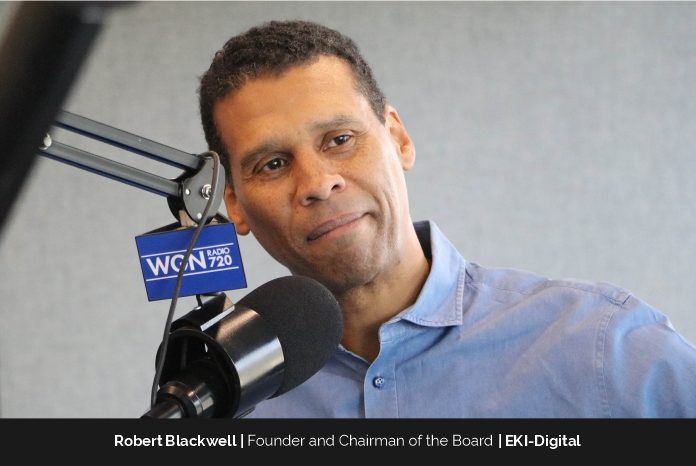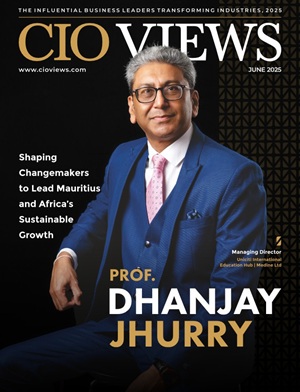
Robert Blackwell Jr., an aspirational entrepreneur is the Founder of Killerspin, the world’s leading table tennis engagement brand, and the Founder and Chairman of the Board for EKI-Digital, a digital investment consulting firm. As a child, Robert was an extreme introvert who was interested in business, philosophy, and math. Today, he is a strong believer in the fact that challenges are the resistance one needs to build new output capacity. He also genuinely believes that numbers can transform organizations and even lives. Math gives us a repeatable, statistical advantage, yet many of us still rely on our guts, however, all through his professional life, Robert has learned that almost anything can be made better if we apply math to it. Robert believes that discovery and invention are what keep him motivated to achieve his goals and that is what makes him a great inspiration to aspiring innovative entrepreneurs.
-Written By: Robert Blackwell Jr.
Founder and Chairman of the Board for EKI
I remember it like it was yesterday. October 19, 1987.
I was looking at the monitors in disbelief. The entire floor of traders on the Chicago Mercantile Exchange was quiet. Traders are never quiet. Today,
however, was different.
We couldn’t believe what just happened.
I was born in Philadelphia, raised in Kansas, but grew up at the Chicago
Mercantile Exchange. That day, Black Monday, will forever be etched in my
mind as a significant day in my life, and I’m sure the same goes for millions
of other Americans.
The stock market crashed as the Dow Jones Industrial Average plunged
508 points, or 22.6% in value, its largest single-day percentage
drop—today’s equivalent would be a 6,000-point drop in the Dow.
It is hard to describe what that day was like to people who were not
involved in the markets. To those who were there, it felt more like a violent
force of nature—a Tsunami or a hurricane.
The systems of open outcry that lasted for more than 150 years and were
such an important part of the Chicago economy no longer exist today for
one very simple reason: People cannot compute as fast as computers.
The Death of Trading Floors
What traders do is look into chaos for recognizable patterns and/or deviations of value (Opportunity Identification) then place bets on the length (Price variance), strength (Volume), and duration (Time) of a wave (Trend) to capture the value of the delta between the current and theoretical value of a financial instrument at a moment in time (Value Capture).
In trading, you look backward for patterns and forward with algorithms that give you a statistical advantage over the force of market efficiency over a defined period of time. You measure and monitor the impact a portfolio of variables can have on the performance of your positions, which determines whether you live
or die as a trader.
Success in trading is about self-control (having courage when most of the world is scared and being scared when the rest of the world thinks they are about to ascend into heaven), data-driven predictive analysis (artificial intelligence), and algorithmic-based action (machine learning). Individual human beings cannot compete with computers when it comes to processing data, using complex
algorithms, or issuing instructions to other computers…and that is why there are no more trading floors.
Let the Computer Do the Work
Traders are now responsible for giving guidance and instructions to computers in a never-ending battle to beat their competitors at identifying and trading on small deviations of theoretical value. The traders of today are math guys, quants. Trading companies are full of these kinds of people.
The industry started as a way for farmers to sell their risk (hedging) to a group of risk aggregators (speculators). Buying insurance is selling your risk to an aggregator of risk, your insurance company. They are making a bet that the sum of the risks they take is less than the sum of the premiums they collect. In this case, you are the hedger and they are the speculator.Portfolio risk pricing and management is at the core of what the insurance industry is, along with most of finance.
An entire industry was transformed from an ecosystem of paper-based processes (trading cards) documenting the verbal agreements (trades) in a physical location (trading floor) during a specific timeframe (trading hours) to one where the computers are running the show. Profits are now determined by computing power which is asymmetrical between large and small algorithmic trading organizations.
As soon as the banks jumped in the trading business, the days of the independent trader and order filler were numbered. They are now like the music CD: There are still some around but not very many. The financial industry is all about relationships and technology now. Computers have won because they can run
algorithms faster than any human.
The Death of IT
By now, you are probably wondering what this all has to do with the death of IT. How can the death of IT be possible in a world where every business is becoming a digital business and every government is in a race to digitize?
There is a desire to digitize and a necessity to clean up the undocumented hodgepodge of obsolete non-supportable technologies built by retiring technology-focused baby boomer developers using a plethora of technologies and development techniques over a series of decades.
Every year, there is a new miracle technology or complex architectural framework that is supposed to solve all the problems related to technology implementation failure. All the beautiful marketing pieces from the technology industry and “experts” in business and academia tell you that they have figured out your path to digital nirvana. If this is true, why is the dissatisfaction with technology investment so high? Dissatisfaction is so high because, in general, the realization of performance-enhancing benefits from digital investments is so low.
Algorithms Win-What Happened to Traders Will Happen to IT
Today’s IT organizations face the same threat that traders working in trading pits faced two decades ago. That is, dissatisfied investors (business owners) that look for performance improvements from data-driven predictive analysis (artificial intelligence) and algorithmic-based action (machine learning). Investors mainly worry about outcomes, usually portfolio financial performance and risk, they
don’t typically care about the processes of the people with whom they invest their money. They are just interested in the results.
In a digital world where everything is changing fast, the algorithms are going to win. You are either going to manage the algorithms or they will replace you. You can’t calculate as fast as they can, so don’t try. Figuring out the range of variables to include in your algorithm is the key to your success. Algorithms can distribute content, calculate, recognize patterns, and present math-based options better than humans, but they can’t create beautiful experiences or establish relationships, that’s still in our domain.
The day is soon coming when investors will pay for outcomes as a service that is aligned to a specific business ratio in IT the same way they do their other investments.
Algorithms that measure the effectiveness of IT investments will likely do the same to the IT industry that they did to the trading industry, create pain for the slow and opportunity for the digital quants.




















